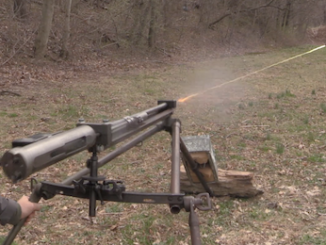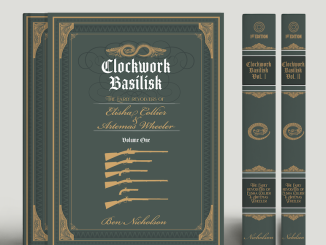One of the more mainstream attempts at incorporating electronic into firearms technology on the civilian market was the Remington EtronX, introduced in 2000. It consisted of a standard Remington 700 bolt action rifle, with the trigger and firing mechanisms replaced by electric versions. The firing pin itself became an insulated electrode, the trigger operated an electronic switch instead of a mechanical sear, and a 9V battery feeding a capacitor provided the energy to ignite the new type of primer – basically a resistor that would generate heat to ignite a charge of smokeless powder.
Remington made a valiant effort with the EtronX, but came up short. Unfortunately, the only practical advantage to the electronic workings was a reduction in lock time of the action (the delay from trigger press to cartridge ignition). They did in fact achieve a virtual elimination of lock time, but this was not a problem that needed to be addressed for the general sporting rifle market. Between questions about ammunition availability and a general market rejection of electronic component in firearms, the rifle failed to sell, and was dropped from Remington’s catalog in 2003.




John C Garand designed a reduced lock time upgrade for the 1903 while he was at Springfield Armory. Reduced the lock time to about half what it was (22msec vs 45msec)with no noticeable improvement in accuracy.
How many shots would you get from a typical alkaline 9V battery?
This is probably a good ignition system for caseless ammo, if Remington wanted to re-invent the wheel to create a market for a proprietary type of ammo, they should’ve shot the wad and gone whole hog.
“good ignition system for caseless ammo”
For electric ignition caseless cartridge see Voere:
http://www.cartridgecollector.net/57-x-26-voere-caseless
Electric priming and trigger would also make tuning the trigger much easier, at least in theory. It would for example enable a bullpup rifle to have a very nice trigger. Designing a set trigger would also be potentially easier.
Probably not enough advantages to make it worthwhile, but a shorter lock time is not the only potential advantage of electric primers. The basic technology itself is quite old and has been in use since WW2 in aircraft weapons and vehicle-mounted autocannons.
“technology itself is quite old and has been in use since WW2”
In fact, if this list https://forum.cartridgecollectors.org/t/complete-list-of-us-t-numbers/6654/7 is true then Remington has experience with electric primers as early as 1940s. See following points:
T81 Cartridge, Incendiary, Caliber .60 (T36E2 Assembled with Remington T41 Electric Primer)
T82 Cartridge, Armor-Piercing-Incendiary, Caliber .60 (T39 Assembled with Remington T41 Electric Primer)
T83 Cartridge, Armor-Piercing-Incendiary-Tracer, Caliber .60 (T60 Assembled with Remington T41 Electric Primer)
T84 Cartridge, Armor-Piercing-Incendiary-Tracer, Caliber .60 (T76 Assembled with Remington T41 Electric Primer)
T84E1 Cartridge, Armor-Piercing-Incendiary-Tracer, Caliber .60 (T76 Assembled with Remington T41 Electric Primer)
T85 Cartridge, High Pressure Test, Caliber .60 (T33 Assembled with Remington T41 Electric Primer)
T85E1 Cartridge, High Pressure Test, Caliber .60 (T33 Assembled with Remington T41 Electric Primer)
If you don’t know what “.60 caliber” is, see http://www.quarryhs.co.uk/MilRel.htm section Based on the US .60″ T17 and the Soviet 14.5mm ATR.
Generally, size-wise it is close to Soviet 14,5×114 and has similar history: created as AT rifle cartridge, later adapted for machine gun use and both spawned necked-up version firing slower but heavier (more HE filler) projectile (20×102 and 23×115 respectively)
“(…)since WW2 in aircraft weapons and vehicle-mounted autocannons(…)”
According to https://ator1149.home.xs4all.nl/wfm/ww1/ammunition3.html
From 1904, the new generation of field artillery was QF with propellant in brass cases with self-contained percussion primers, while small naval QF cases had self-contained electric primers.
So it seems that it was in naval use before First World War.
According to https://en.wikipedia.org/wiki/QF_12-pounder_12_cwt_naval_gun
The cordite propellant charge was normally ignited by an electrically-activated primer (in the base of the cartridge case), with power provided by a battery. The electric primer in the cartridge could be replaced by an adaptor which allowed the use of electric or percussion tube to be inserted to provide ignition.
So in fact electric priming was probably first used no later than in 1894.
That was one of the most useless systems ever developed
I suspect that while the rifle has proved the concept completely feasible, it has also proved that the practical application of electrical priming is definitely NOT for civilian firearms. I know for a fact that the Tiger Tank’s 8.8 cm KwK 36 could use both conventional percussion-primed and electrically-primed ammunition, as it shared the shells with the 8.8 cm Flak 36. The percussion-primed cases were meant for the Flak guns, while the electrically-primed cases were intended for use by the Tiger. This begs me to ask how the Tiger could do such a thing. And how could one fire the main gun if the engine was knocked out? Was there an emergency firing system like a pyrotechnic charge? SOMEBODY SAY SOMETHING!!!
“This begs me to ask how the Tiger could do such a thing”
For info see 54th page of this pdf: http://www.lexikon-der-wehrmacht.de/Waffen/Merkblatt/Die_Tigerfiebel_Handbuch_des_deutschen_Tiger_Panzers_.pdf
If you want to fire Flakmunition you need to replace Schlagzündschraube with Glühzündschraube
“Was there an emergency firing system”
According to linked pdf there was Notbatterie (emergency battery)
is: “(…)Schlagzündschraube with Glühzündschraube(…)”
should be: “(…)Glühzündschraube with Schlagzündschraube(…)”
Notice that http://tanks-a-lot.tumblr.com/post/157086612262/hey-enrique-i-have-a-question-for-you-apologies#notes suggest that Pz. IV D has bar under gun barrel to avoid short-circuit with aerial
The 105 mm main gun on the US M60 series tank was/is electrical fired. In cases where the mechanism failed, a regular hand held blasting machine for electric blasting caps was fixed next to the gunner. All he had to do is twist the handle and it generated enough current to fire the round. Not sure about the M-1 series. Haven’t been in one, but expect the same.
I immeidately thought of one of my freshman English professor’s catchphrases: “post-optimal technology.”
I predict that when manufacturing sheets of carbon nanotubes such as graphene become much, much cheaper and easier (say, in a year or two), eventually stuff like this will start to take off easier to bash through the thoughts of “electronic components in guns = bad” and “They tried before, but failed. So why bother again?” to create some pretty sweet new designs for stuff like scopes and other things you can hide the stuff in, like an ultra thin display on the side of a magazine to count the ammunition inside it by using another sensor internally.
Of course, there will still be quite a few obstacles, but I have a good amount of faith that some good things will happen.
Amazing what kind of doors open when you stick a piece of tape to a block of graphite!
“(…)electronic components in guns = bad(…)”
Metallic cartridge is called self-contained for reason, if you want to use electric (not necessary electronic) priming you need (external from cartridge) voltage source, which negate self-contained attribute.
Not really. Even self-contained cartridges require an external system to work and it’s basically just a matter of choice whether that system is mechanical (firing pin) or electric. If the firing pin is broken, the gun will not fire. Traditionally electric systems have been considered to rely too much on availability of a power source (e.g. battery) to be practical for small arms, but that might change in the future.
“Even self-contained cartridges require an external system to work and it’s basically just a matter of choice whether that system is mechanical (firing pin) or electric.”
Electric primer cartridge needs voltage, from user point-of-view: you have to supply battery to use “electric” firearm along cartridge and in case of percussion primed cartridge you don’t have to do this.
Quite correct. I have owned firearms, which have fired certainly tens of thousands of rounds, with the original firing pin and lock components. Some of these have been a hundred or more years old.
How many batteries have any of us seen that are reliable, under any conditions, after a hundred years? All one accomplishes by adding another item to the list of things one needs to shoot (i.e. a battery) is to add another thing to the list.
I could, theoretically, if given a vise, file, and an old nail, make a firing pin that would function. It might be ugly and even possibly unsafe, but I could do it. How many people have the resources and facilities to make a battery?
You compare future electronic guns with smart phones but given the state of malware we’re dealing with now, such a gun could be far more dangerous than intended. I think I’ll pass.
“smart”
For automatic pistol with that word in name see Armatix iP1 Smart System
Excellent point about iphones. And remember, every model that comes out requires a new, different, proprietary battery that can’t even be removed. They also always seem to go bad after a year or so.
Is that what we want with our firearms?
This might be OK in places like Europe or Canada, where shooting has been relegated to the rich and influential as a weekend hobby (i.e. who cares if your gun works right in France – you guys are just playing around anyway), but over here in the US, we still need our guns. And we need them to fire every time we squeeze the trigger, not just on days where QT is open and we can buy batteries.
The whole concept reminds me of the “why don’t we have flying cars” whining you see from time to time.
CG
I wonder if the name contributed to flaw the project…
http://www.wordreference.com/fren/%c3%a9tron
Joke aside, electrically primed ammo seems interesting.
Did anyone simplified enough the concept to run a simple design (ie: single shot black powder) with a standard igniting system like electric arc from gaz lighter, conductive wire in the chamber or even within a cartridge, which could be activated by direct connexion or induction?
“induction”
This might give some opportunity – there might be not hole in case bottom used normally for primer, so it should allow high pressure without problems with primer blowing out.
Apart from lock time and the ease of making a good trigger, electrically primed ammo would allo you to make primers lead free, which is something the industry is struggling to achieve. The lack of any vibration caused by a firing pin would contribute to accuracy, especially in smallbore and benchrest rifles.
Austrian company Voere failed with a pretty futuristic caseless electronic rifle, but recently came back with an electronic firearm that – lo and behold – shoots a laser at a primer, thus creating heat to ignite it.
That having said, I just had to throw away a flashlight when the battery started leaking. Don’t want that to happen with my rifle.
Just tread your gun better than your flashlight and change the battery reagulay. Do not wait for years untill the battery start leaking.
Eliminating lock time sure helps when your shooting prairie dogs at over 800 yards. I had one in a 220 Swift that would regularly hit them at those distances.
A missed opportunity here would have been the development of permanent electrically fired primers.